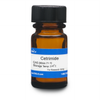Cetrimide is a bactericidal cationic surfactant used against Gram-positive bacteria. It is freely soluble in water.
This product is considered a dangerous good. Quantities above 1 g may be subject to additional shipping fees. Please contact us for questions.
| Application | Cetrimide is used to study the foam films produced from surfactants. It can be used as a cationic detergent for isolation of high molecular weight DNA in plants. |
| Microbiology Applications | Cetrimide is often used in selective media for Pseudomonas aeruginosa. Enterococcus faecalis can grow as a biofilm in the root canals of teeth. Using a MBEC-high-throughput device to study these types of biofilms, authors found that an irrigating solution of Cetrimide was able to eradicate the bacteria (Arias-Moliz et al, 2010). |
| Plant Biology Applications | Cetrimide is an active ingredient in Cetavlon, a detergent and antiseptic used in plant/tree tissue culture prior to surface sterilization. A commercially important tropical fruit tree in India is the blackplum (Syzygium cuminii L ). Seeds were treated with 1% (v/v) Cetavlon prior to surface sterilization (Yadav, 1989). Newly developed leaves from apical portions of Guava plants were treated with 1% (v/v) Cetrimide prior to surface sterilization (Amin, 1986). |
| References | Amin MN and Jaiswal VS (1987) Rapid clonal propagation of guava through in vitro shoot proliferation on nodal explants of nature trees. Plant Cell Tiss Organ Cult. 9:235-243 Arias-Moliz MT, Ferrer-Luque CM, Gonzalez-Rodriguez MP, Verderrama MJ and Baca P (2010) Eradication of Erterococcus faecalis biofilms by Cetrimide and Chlorhexidine. J. Endodontics. 36(1):87-90 Yadav U, Lal M and Jaiswal VS (1990) In vitro micropropagation of the tropical fruit tree Syzygium cuminii L.. Plant Cell Tiss Organ Cult 21(1):87-92 |



